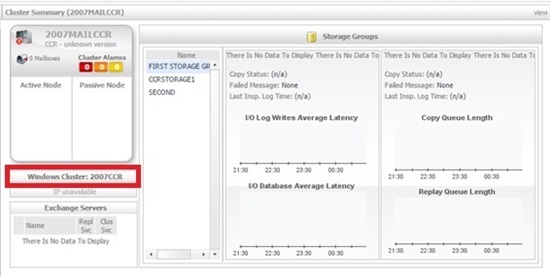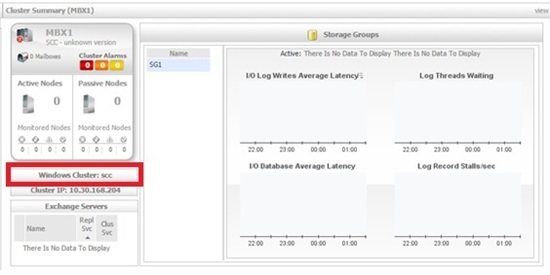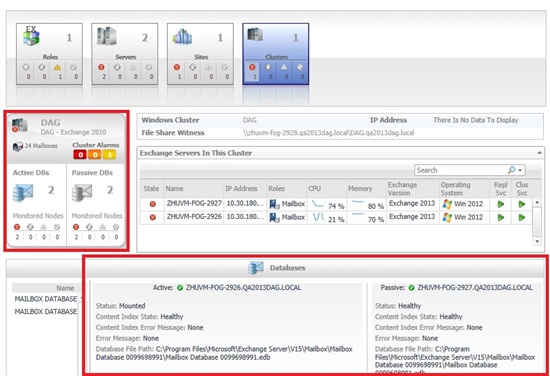When we look at high availability capabilities built into Microsoft Exchange it becomes clear the available options vary depending on MS Exchange version. In this blog I would like to highlight the high availability options in Exchange 2007, 2010, and 2013 with regards to Foglight’s supportability.
As you may know Microsoft Exchange 2007 supports two types of cluster setup, which are: Cluster Continuous Replication (CCR) and Single Copy Cluster (SCC). CCR is built on using the database failure recovery functionality to enable continuous and asynchronous updating of a second copy (passive node) of a database with the changes that have been made to the active copy (active node) of the database. Foglight for Exchange cartridge added the support for monitoring Exchange environments with CCR several releases ago.
Please see below for the Foglight screenshot:
A Single Copy Cluster is basically a clustered mailbox server which is made up of two or more nodes that share the same database and transaction log. SCC provides high availability for Exchange server via an active/passive node structure. So if the primary (active) node fails for whatever reason, the passive node will take over. There are additional benefits in having an SCC environment such as, applying Hot Fixes, Service Packs, etc. The important thing to note is that SCC is built around shared storage and does not protect the Exchange environment against disk/database failure. In the most recent release of Foglight for Exchange (5.6.8) we now support monitoring SCC environments as well.
Please see below for the Foglight screenshot:
With the MS Exchange 2010 and 2013 Microsoft introduced a new high availability feature called Database Availability Group (DAG). A Database Availability Group consists of multiple Exchange Mailbox servers that are capable of hosting a copy of a mailbox database from another DAG member (via Replication). This would ensure availability of the mailbox database and allow the users to connect and access their mailboxes in case of any failure. For example if the server that hosts the active database encounters hardware failure, one of the passive DAG members will immediately become active to eliminate any interruption to the Mailbox availability. Foglight supports monitoring environments with DAG configuration by showing the status and health of both Active and Passive databases.
Please see below for the Foglight screenshot:
Foglight is the premier solution for performance monitoring and management across multiple technologies, which include: applications, databases, Operating Systems, Storage, and virtualized infrastructure. Foglight for Exchange cartridge helps organizations quickly detect, diagnose and resolve performance and availability problems affecting Microsoft Exchange server in both physical and virtual environments.
For more information please visit Foglight for Exchange web page:
https://www.quest.com/products/foglight-for-exchange/





